Hey, anybody out there know about electricity? I’m getting mixed opinions on a wiring decision. I’m a carpenter in PA and an electrician I know said to run 12/3 wire to my upper floors and run two seperate circuits off of it. I had another electrician tell me not to do that because the double breaker needed may not trip as it is supposed to. Please help! I know wood, not copper. Thanks
Discussion Forum
Discussion Forum
Up Next
Video Shorts
Featured Story
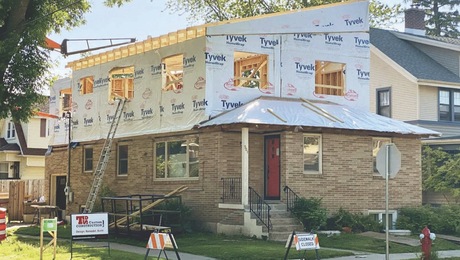
Get expert guidance on finding a fixer-upper that's worth the effort.
Highlights
"I have learned so much thanks to the searchable articles on the FHB website. I can confidently say that I expect to be a life-long subscriber." - M.K.
Fine Homebuilding Magazine
- Home Group
- Antique Trader
- Arts & Crafts Homes
- Bank Note Reporter
- Cabin Life
- Cuisine at Home
- Fine Gardening
- Fine Woodworking
- Green Building Advisor
- Garden Gate
- Horticulture
- Keep Craft Alive
- Log Home Living
- Military Trader/Vehicles
- Numismatic News
- Numismaster
- Old Cars Weekly
- Old House Journal
- Period Homes
- Popular Woodworking
- Script
- ShopNotes
- Sports Collectors Digest
- Threads
- Timber Home Living
- Traditional Building
- Woodsmith
- World Coin News
- Writer's Digest
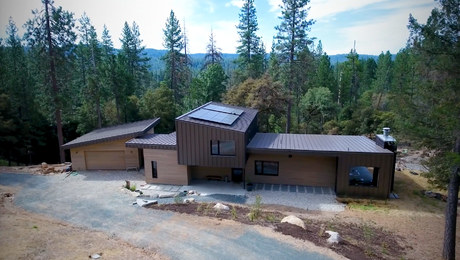
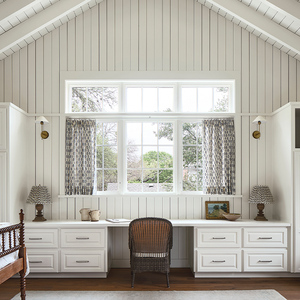
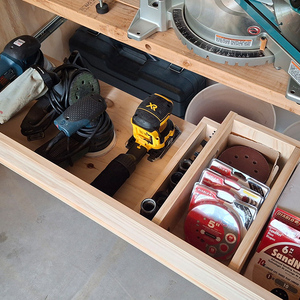
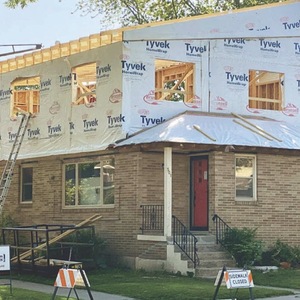
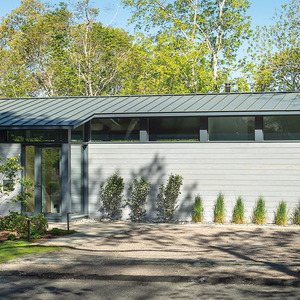













Replies
12/3 or any other /3 has two hots (red and black) and one neutral(white). Its used to lessen the amount of romex you pull or do very light duty 220. (correct me if im wrong) each hot will have its own breaker, and if its a quality breaker, it will break when its designed to break.
Hey Bill, isn't it possible to overload the capacity of the neutral if both hots are carrying full capacity? If you're using 15A breakers, and each hot is carrying 12A, doesn't the neutral then carry 24A?
Only if both hots are attached to the same leg of the 220. If one hot is attached to each leg of the 220 and they are carrying the same load, the neutral is actually carrying zero current.
The trick is that in a residence there is no way to guarantee that some genius won't come along and think up what seems to be a good reason to put both hots on one leg. (Of course there's no way to guarantee that won't happen on a commercial job either.)
Edited 9/27/2002 10:06:13 PM ET by Uncle Dunc
Thanks for the info guys. To follow up I thought when you ran 12/3 you had to use a double breaker becaue there is only on neutral. Does this mean you think that the cover on the double switch can be removed to allow each switch to operate alone. Please excuse my ignorance but I don't know that much about electricity. I called the city I live in and was told, rudely I might add, that they are there to inspect not to "design".......politicians at ther best I guess. Thanks a lot for your help! Bob
Ok, I'm going to post my thoughts, partly to show how smart I am :) but mostly to see if what I think is correct. Two breakers that are tied together are supposed to trip at the same time so that all power to the appliance is cut. If you remove the tie bar and one breaker trips, the other hot is still sending juice to part of the appliance. If a serviceman turns off what he thinks is the power supply, he may actually have half the appliance still hot. (Appliance of course means whatever is connected to the other end of the wires.)
Now for my ignorant part: Why does the neutral carry no load if the hots are on different legs? Wy have a neutral if it doesn't do anything?
I guess I should make this a little clearer what I mean. The advice I was given was to run the 12/3 and use one hot for outlets and the other for lighting. The idea being to save running two 12/2s. I got mixed opinions from two different electricians so I asked here. I guess I should just run the two lines and stop being lazy. Like I said I'm a wood man.
Thanks for responding though, Bob
If it makes you feel better, I know almost nothing about electricity, but what you brought up is interesting.
Your first electrician is trying to save running two runs to your upper floors by using 12/3 wire. I am sure it will be tied into two breakers on the panel just as if he had run two 12/2 lines.
The neutrals from all of your circuits connect onto a common bar in your panel, so why wouldn't this work? In a worst case scenario you could have both of the circuits overload at once? If so, is that a big deal? I have never seen or heard of this, so is it up to code?
For what you are doing this is fine. He wants you to pull the twelve three to a box where the light switches are going to be. Then you are going spilt the two "hots" as you call them. One is going to run the recepticals, and one the light fixtures. Pretty basic stuff.
Sharing neutrals is very common. If you open the cover on just about any comercial panel you will see for example 15 commons leaving a panel and four neautrals, same for grounds. The only drawback to doing this is you don't have a dedicated circuit. Meaning if something were to happen to a neutral along the line say for example you were working on it and untwisted the neutrals to add another, everything that shared that neutral would lose power because you broke them apart. That's why computers and crucial equipment are always on dedicated circuits, meaning they have their own neautral and ground that go back to the panel. If you stand back and look at the big picture the whole house is sharing the same neutral. They all screw down to the same bar don't they?
one neutral can run two hot wires. 220 does this exact thing, but the amp ratings are halved on 220 vs 110. load capacity is based on wire gauge and the breaker contolling the circuit the specified voltage. Also there should be some consideration to the length of the circuit, since it primarily deals with voltage drop. Best advice on actual projects is to consult a competent licensed sparky who is familiar with the codes adopted by your location. But understanding the basics is advisable.
Edited 9/28/2002 12:09:41 AM ET by BILL_1010
For the purpose of not confusing the original poster. I kept my response simple. He didn't ask about 220 or balancing. An electrician asked him to pull a wire, he was confused since he was getting conflicting stories. I offered a simple basic explanation. One that stuck to the subject. If you start getting off topic and throwing in factors that aren't there, and changing the scenario then your only going to confuse him with stuff he doesn't even want or need to know. And you don't run a neutral with 220.
Edited 9/28/2002 8:02:13 AM ET by Gunner
Thanks for the responses guys, it cleared it up for me.
Bob
right no neutral to 220, it was late and white can be hot in 220. white clicked neutral.
Good old brain fart. Gotta love em. :)
Edited 9/28/2002 4:47:54 PM ET by Gunner
Edited 9/29/2002 8:21:16 PM ET by Gunner
If you do this, tag the two breakers with a colored tag and have a like colored sticker on the box describing the setup.
This should deter a future would-be wire junkie from somehow putting both breakers on the same leg.
I think some people are really confused over a simple issue, as an electrician we often run a 3 wire to carry 2 circuits. It doesn't cause problems and it really saves you money in the long run. If another electrician cannot figgure out the circuit he should either go back to school or find another trade.
Bake
As you said, around here they do it all the time, called homeruns, I thought that the electrician told me that they(the black and red ) had to be be on opposit sides in the breaker box. Not an electrician but this seems very simple electrical prob.
Doug
Thats correct, the red and black should be on their respective phases. I stand my ground concerning "home runs" people who don't have the good sence to figgure out common circuitry have no business in the panel! 3 wire circuits are the norm.
bake
"people who don't have the good sence to figgure out common circuitry have no business in the panel!"
But people who have no business messing with their wiring do so all the time. Why set up an easily avoided potential problem situation that will only save you 5 bucks?
Veni, vidi, velcro: I came, I saw, I stuck around.
Boss
I thought that what Bake was saying was proper wiring code and I checked with an electrician today and he said the same thing that Bake said, homeruns are common and excepted practices, also if someone does not know this very basic wiring practice than they should not be putting there hands in a panel, this is elementry wiring!
Someone mentioned the price of the wiring and that has very little to do with it, the labor is more than the cost of the wire, run one homerun as opposed to two 12/2 wires and add that up over the durration of the job.
Doug
veni, vidi, veni, I came, I saw, I came (sorry for the moddification)
" if someone does not know this very basic wiring practice than they should not be putting there hands in a panel"
You can say that 'till you go to your grave, but people without a clue do it every day. Repeating phrases like that might make you feel better, but won't keep people from messing around with their wiring when they don't have a clue.
While you can't make it "idiot proof", I think you can make it more "idiot resistant".
Hey - Did I just coin a new phrase here ???
If only women measured charm by the amount of methane produced.......
How about "idiot friendly."
Boss
Sometimes you just have to weed out the week!
You cant make everything "idiot resistant" some people have no business in the panel and if they insist on doing things that they shouldn't than what the hell you going to do to prevent it?
I think that there are a lot of things that people can get hurt on in your typical house but you cant fool proof the whole thing, nor would I care to try.
Doug
Guess we should team up Doug, because I am not going back to knob and tube so unqualified people can guess their way through. I see everyday what SOME people will do.... and it makes little difference what my wireing methods were before the got their mitts in there.
Customers call us in to do what we do and I don't often ask how they want their home runs laid out unless they have specific needs. If there are changes that need to be made in the future these customers call us back.
Here 3 wire costs about 1 1/2 times more than 2 wire, we typically use 3 wire at a 2 to 1 ratio over 2 wire. There is a savings and I think that money is way better off being spent on hard wired smoke dectors, more outlets and labour to not use the quick wire terminals on devices.
IMHO it would be prudent (or polite) to label everything in a panel that could make it easier for the next qualified electrician to quickly and easily understand what he's looking at. Put yourself in his shoes...if you opened a panel for the first time and saw notes or labels for odd circuits, wouldn't it make your job a little easier?
"You cant make everything "idiot resistant""
No, but this is something that's really simple that could keep someone from burning their house down. Seems like that would make sense to do instead of adopting such an arrogant attitude about it.
I'm not 40-something. I'm $39.95, plus shipping and handling.
There is a distinct difference between being arrogant, and not accepting other people's stupidity.
You don't expect your local garage to label your lug nuts with a sticker reading "Do not Remove" after a tire rotation, do you? Of course not. And I think we would all agree that if you (or whoever, this isn't meant personally) were dumb enough to loosen or remove them all and have your wheels fall off, it would be _your_ fault, not the garages.
At some point, people have to take responsibility for their own actions - if you want to mess around in an electrical panel, and don't know enough about it, it is YOUR fault, not the previous electricians. It is not his/her responsibility to make sure an unqualified amateur can understand what has been done. Although I'm sure that if you were willing to pay the extra money for time and materials, they would label everything quite nicely...
d-
Boss
I guess I take exception to being called arrogant when doing something proper and by code. If you don't understand what to do in a panel than stay the hell out of the damn thing and let the people that do know do the work.
Its interesting that your lack of knowledge on this subject forces you to refer to my knowledge of the subject as arrogance.
Doug
Doug,
Thanks for proving Boss's point.
We all understand and agree with you that unqualified people shouldn't mess with wiring. The point that Boss and Mongo and I and probably others were trying to make, the point that you are apparently too arrogant to read and understand, is that there is nothing you can do to keep morons from working on their own wiring. However, there is a way you can keep them from burning down the house by moving half of a shared neutral circuit to the wrong hot leg, and that is by not installing any shared neutral circuits.
Or are you saying that unqualified people who work on their own wiring deserve to burn the house down? That strikes me as more than a little arrogant.
The NEC, like all building codes, is a minimum standard. Not every code compliant installation is ideal. Only an arrogant electrician would install a known risky circuit, justify it by citing the code, and blow off the possibility of a future homeowner harming himself and his family by saying he shouldn't be messing with the wiring.
The lug nut analogy doesn't hold water either. If someone takes the lug nuts off a wheel, the results are sudden and dramatic. Overloading a shared neutral after one of the breakers is accidentally moved depends entirely on the load pattern. The circuit might work faultlessly for years, and fail only when the load is increased or rearranged.
Unc
I guess the fact that you and Boss have to resort to calling someone arrogant because they don't agree with you makes what you say suspect at the onset.
I disagree with you on the subject, maybe according to you that makes me arrogant or maybe I just don't know what the definition of arrogance is.
Read into it what you want, but if someone is doing something in there breaker box that they shouldn't then how the hell is anyone supposed to protect them.
I stand by my thoughts on this and you can on yours, doesn't really matter, not quit sure here but someone needs to figure out what the meaning of arrogance is.
Also because you proclaim you and Boss's point proven, well that almost rings of arrogance, just a bit.
Doug
I think this thread has degenerated from a useful discussion to one that's simply a pissing contest. Anyone who actually intended to learn anything from this has already done so.
I don't plan to continue with it.
>> If another electrician cannot figure out the circuit he should
>> either go back to school or find another trade.
I won't speak for the other respondents, but I'm not worried about some future electrician failing to figure out the circuit. I'm worried about some future homeowner changing it without even trying to figure it out. If you never install a shared neutral circuit, then nobody can ever overload the neutral by mistakenly putting both hots on one leg of the 220.
Agreed, Uncle Dunc.
Is it an end-of-the-world concern?
No, but a shared neutral is uncommon enough to warrant bringing it to the attention of someone who cracks open the panel with a 500' spool of lamp cord in hand, to be used to run a circuit to the new hot tub.
If you're going to run wire this way, take 20 seconds and tag it.
Mongo
It certainly won't hurt. But I am of the opinion that the people with the 500 ft spools of lamp cord already KNOW WHAT THEY ARE DOING and will claim that any such label is wrong.
I have two furnaces that are in the same room. They where feed by a 12-3 cable to a box by the furnaces. Some, I am suspecting the Hvac people her, installed one switch to control both furnaces and tied the two hots together to the feed the switch. Then they moved the feed at the breakers so that they are on the same breaker.
I am working on a house now that has broken almost every rules that that is in the NEC.
I took down part of the drywall ceiling in the basement to look for a suspected burried junction box. I found that one. But in the process found a whole mess where they just tapped runs of a feed and used a 500ft spool of tape and left them hidden in the ceiling.
But as I said, it can't hurt to mark the split neutrals, but don't count on it helping.
12-3 is a lot more money than 12-2. I don't think you save anything using the 12-3 versus 2 runs of 12-2. Count me out on that one. I use 3 conductor for ceiling fans with lights or for 3 way switches.
yea brain farts is what made me have my sparky only use red and black for my 220 runs. I have too many brain farts, especially on mondays and fridays.
You might try a friendly call to the city plans examiner or electrical inspector and ask for advice.
I think the electrician is saying run the two hots to 2 separate breakers, using the common neutral.
Neat concept, how does it fly by the electrical code?
>> Neat concept, how does it fly by the electrical code?
I can't cite chapter and verse, but yes, the code does contemplate this kind of installation. You can even use a smaller neutral conductor, sized for the maximum difference between loads on the two hots. I don't know for sure if it's allowed in residential wiring, but it's in there.
I just talked the HO out of doing this on his own house. NEC does allow it and some electricians advocate it as do some of the DIY books. I personally don't like it because if the neutral is ever compromized for whatever reason and one of the legs is running an appliance, like a fridge, you could fry a compressor motor.
At any rate, the few cents you save by running a 3 wire circuit is hardly worth the confusion you may create for some schmuck down the road who wonders "how is this 3-way circuit wired."
I agree. Too much risk for too little gain. But there's no doubt it's technically cool. Wow! Zero current on the neutral? It captures people's imaginations. It captured mine, briefly.
I`m not sure if it is actually zero amps. Since the two hots are 120 electrical degrees apart (at point of generation) I believe the neutral is carrying a percentage difference of the two loads. It`s funny that I was so good in theory in school and over the years ones knowledge (rememberage?) begins to atrophy. Use it or lose it. Like in 220 v, one line is increasing in amplitude and the other one is lagging in phase relation therefore decreasing in amplitude and that creates the difference in potential (voltage) and corresponding current flow (amps). If someone can verify what I just said, I`d love to know how close I am on this. I think I may have hurt my brain...
My understanding is that single phase or two phase or whatever you call ordinary household electricity is 180 degree apart. Three phase is 120 degrees between phases.
If I recall my electrical courses, at the point of generation, there are 3 phases, 120 deg apart. The phases aren't changed by transformers, so when you have it stepped down to 110/120, and use two phases for 220/240, you are using two of the three original phases. I could, of course, be wrong on this. And I'm not going to pretend I'm an expert.
You are partly correct. At the point of generation ( my profession) the power is 3 phase, 120 degrees apart. At the distribution point, the transformer at the top of the pole, one of the phases is stepped down to 110 and the polarity is reversed or offset 180 degrees to give you the 2 hots or 220 V. The voltage varies according to power demand on the distribution network and can vary from 110 to 120/220 to 240. The power in between the generation end can vary from 18-24KV at the generator up to 138KV, 345KV, or 765KV, and others in between for the transmission lines, and back down in steps to lower voltages for the distribution networks, usually around 22KV, I think.
Lefty - Lurker without an attitude or a clue
Phase reversed. Aha. That's why I became a mech eng, not an electrical. Oh, well. Since I work with industrial equipment, I only have to worry about 4160v, 2300v, 575v (here in Canada), 460v, 230/208v etc etc etc.........
I'm a Mech. E too but I've had to learn this electron stuff after 20+ yrs. in a power plant. Its funny how this electrical stuff has to be so complicated, yet the wires just have to touch for it to flow while the so called simple stuff, piping, has to be perfectly aligned and connected with no holes for the water to flow. <g>
Lefty - Lurker without an attitude or a clue
All this crazy mathematical stuff on phases and legs and neutrals just to keep the smoke in the motors, plugs and bulbs so it(smoke) doesnt leak out and make the motors and whatnot stop running.
> At the distribution point, the transformer at the top of the pole, one of the phases is stepped down to 110 and the polarity is reversed or offset 180 degrees to give you the 2 hots or 220 V.
Actually it's simpler than that. One phase of the high voltage is run to the primary of the transformer. The secondary of the transformer has a center tap, so there are three wires coming out, 240 volts between the ends of the secondary, and 120 between the center tap and either end. Viewed from that center tap, when one end goes positive, the other goes negative. They're naturally automatically 180 degrees apart.
Because the secondary of a transformer floats with respect to the rest of the world, theoretically we are free to choose what to ground, or even not to ground anything. The standard is to ground the center tap and call it the neutral.
-- J.S.
Thanks for the info, John. I've spent my whole time on the coal burning end of the process and tried to learn the rest of the business but that magical electron stuff was too much for a dumb ME like me. <g> I pick up info where I can but we acid rain creating monsters don't get much contact with the clean end of the business. Thanks.
Lefty - Lurker without an attitude or a clue
If the phase angle were other than 180 degrees, then any inductive load across the 220, such as transformers and motors, would not see a sinusoidal wave form and would be very unhappy.
You could also do a Google search for
"220 volts" phase "180 degrees"
I got about a dozen sites that describe household 220 as being 180 degrees out of phase. The most authoritative one appeared to be http://www.acesanjose.com/FAQ.htm
"220 volts" phase "180 degrees"
Yes, the two legs of a 120/240 system are separated by 180 degrees of phase.
"If the phase angle were other than 180 degrees, then any inductive load across the 220, such as transformers and motors, would not see a sinusoidal wave form and would be very unhappy. "
Wrong. You are adding up sinusoidal vectors. The results are still sinusoidal, but they results is not 240 volts. It is 208.
This is a common supply in large office buildings what have a large 120 volt loads. They use 3 phase supplies with 120 volts on each phase to neutral. But the phase to phase is 208. So a lot of the lights and AC run on 208.
>> The results are still sinusoidal ...
You're right. Looks like my built in difference of sines processor needs maintenance. I was expecting a wave form with a notch at plus or minus 60 degrees from the peaks.